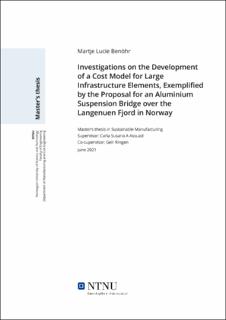| dc.contributor.advisor | Assuad, Carla Susana A | |
| dc.contributor.advisor | Ringen, Geir | |
| dc.contributor.author | Benöhr, Martje Lucie | |
| dc.date.accessioned | 2021-09-29T16:19:34Z | |
| dc.date.available | 2021-09-29T16:19:34Z | |
| dc.date.issued | 2021 | |
| dc.identifier | no.ntnu:inspera:77287502:47664044 | |
| dc.identifier.uri | https://hdl.handle.net/11250/2786108 | |
| dc.description.abstract | Aluminium har et stort potensial som materiale i store konstruksjonsprosjekter, spesielt med tanke på dens egenskaper som kan gi redusert vedlikehold og økt levetid på konstruksjonene. Likevel er bruken av aluminium liten i store konstruksjoner i motsetning til mer tradisjonelle valg som stål og betong, noe som ofte er begrunnet med høyere investeringskost eller innkjøpspris på aluminium.
Denne masteroppgaven undersøker om en kostnadsmodell kan være et egnet verktøy til å imøtekomme bekymringer om høyere startkostnader, hvordan en slik modell skal bygges opp, og hvilke spesifikke anvendelser den kan tjene. Arbeidet i denne masteroppgaven er basert på konseptet for en ny bro i aluminium over fjorden Langenuen, som er en del av veiprosjektet Ferjefri E39. En buttom-up prosessbasert kostnadsmodell med hensyn til egenskapsbaserte fremgangsmåter ble utviklet. Egenskapsbaserte tester og en følsomhetsanalyse har vist at modellen er egnet til å avdekke kostnadsdynamikken avhengig av forskjellige design- og prosessparametere. Dessuten ble kostnadsmodellens evne til å bidra til forståelse av kostnader, og fremme diskusjon som nevnt i litteraturen, bekreftet.
På grunnlag av testresultatene, erfaringene fra modelleringsprosessen, og relevant litteratur, ble en hybrid buttom-up prosess og egenskapsbasert kostnadsmodell identifisert som en passende fremgangsmåte for kostnadsmodelleringer av store konstruksjonselementer. Integrering med CAD-programmer, databaser for egenskaper, og simuleringsverktøy har vist seg uunnværlig. Flere tenkelige anvendelser for denne type kostnadsmodell har blitt drøftet, herunder målkostnad og oppfyllelsen av målsetninger som f.eks. er tilknyttet bærekraft. For en omfattende sammenligning av kostnader ved ulike materialvalg, er livsløpskostnadsmodeller vurdert som mer velegnet enn den foreslåtte kostnadsmodellen.
Resultatene fra denne oppgaven viser at kostnadsmodeller kan støtte kostnadseffektive produkt- og prosessdesign, redusere investeringskostnadene i prosjekt, og øke konkurransedyktigheten til aluminium i konstruksjonselementer. | |
| dc.description.abstract | Aluminium has the potential to enable extended service life and reduced maintenance of infrastructure elements. Nevertheless, aluminium is not as popular as steel and concrete for the construction of large infrastructure elements such as bridges, mainly due to higher initial costs.
This master thesis investigates whether a cost model could be a suitable tool to address concerns about higher initial costs, how such a cost model would have to be built and which specific uses it could serve. The research in this thesis is based on the concepts for the construction on an aluminium bridge crossing the Langenuen Fjord, which is part of the Norwegian E39 Coastal Highway Route project. A bottom-up process-based cost model that also incorporates feature-based approaches was created. Feature-based tests and a sensitivity analysis have proven the suitability of the model to reveal dynamics of costs depending on different design and process parameters. In addition, the ability of cost models to contribute to the understanding of costs and to stimulate discussion, as mentioned in literature, was confirmed.
Based on the test results, experiences from the modelling process, as well as related literature, a hybrid bottom-up process and feature-based cost model was identified as a suitable approach to cost modelling for large infrastructure elements. Integration with CAD software, feature databases and simulation software were found to be indispensable. Several conceivable applications for this type of cost model were discussed, including target costing and the achievement of objectives such as sustainability. For a comprehensive cost comparison of different material options, life cycle cost models were evaluated to be more suitable than the proposed cost model.
The findings of this thesis demonstrate that cost models can support cost-effective product and process design, reducing initial costs and increasing the competitiveness of aluminium for infrastructure elements. | |
| dc.language | eng | |
| dc.publisher | NTNU | |
| dc.title | Investigations on the Development of a Cost Model for Large Infrastructure Elements, Exemplified by the Proposal for an Aluminium Suspension Bridge over the Langenuen Fjord in Norway | |
| dc.type | Master thesis | |
